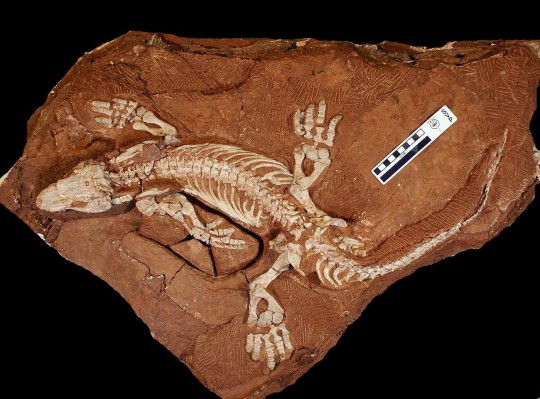British paleontologists have found signs of a degenerative condition similar to human arthritis in the jaw of a pliosaur, an ancient sea reptile that lived 150 million years ago. Such a disease has never been described before in fossilized Jurassic reptiles.

Artist’s restoration of the pliosaur Pliosaurus (Dmitry Bogdanov)
The scientists studied a giant specimen of the pliosaur Pliosaurus dating from the Upper Jurassic. The specimen was found in Westbury, UK, and has been kept since its discovery in the collections of the Bristol City Museum and Art Gallery.
The 8 meter long pliosaur was a terrifying creature with a large, crocodile-like head, a short neck, whale-like body and four powerful flippers to propel it through water in pursuit of prey. With its huge jaws and 20 cm long teeth, it would have been capable of ripping most other marine reptiles or dinosaurs to pieces, but this particular individual was the unfortunate victim of an arthritis-like disease.

Dr Judyth Sassoon of the University of Bristol, a lead author of the paper in the journal Palaeontology, noticed that the specimen had the signs of a degenerative condition similar to human arthritis, that had eroded its left jaw joint, displacing the lower jaw to one side. This animal evidently lived with a crooked jaw for many years, because there are marks on the bone of the lower jaw where the teeth from the upper jaw impacted on the bone during feeding. Clearly the animal was still able to hunt in spite of its unfortunate condition.
There are several signs on the skeleton to suggest that the animal could have been an old female who had developed the condition as part of the aging process. The pliosaur’s large size, and the fused skull bones, suggest maturity. It is identified, very tentatively, as possibly female because its skull crest is quite low – presumed males had a higher crest.

Dr Judyth Sassoon with the lower jaw of the Westbury pliosaur (Simon Powell)
“In the same way that aging humans develop arthritic hips, this old lady developed an arthritic jaw, and survived with her disability for some time,” Dr Sassoon said. “But an unhealed fracture on the jaw indicates that at some time the jaw weakened and eventually broke. With a broken jaw, the pliosaur would not have been able to feed and that final accident probably led to her demise.”

Pliosaurs were probably pursuit or ambush predators, feeding on fish, squid and other marine reptiles but would also have been capable of scavenging. They were at the top of their food chains, so there would not have been any predators to take advantage of an aging, disabled pliosaur – except for another pliosaur.

“You can see these kinds of deformities in living animals, such as crocodiles or sperm whales and these animals can survive for years as long as they are still able to feed,” said study co-author Prof Mike Benton of the University of Bristol. “But it must be painful. Remember that the fictional whale, Moby Dick from Herman Melville’s novel, was supposed to have had a crooked jaw!”
The pliosaur from Westbury is an amazing example of how the study of disease (paleopathologies) in fossil animals can help us to reconstruct an extinct animal’s life history and behavior and to show that even a Jurassic killer could succumb to the diseases of old age.
Source: sci.news





